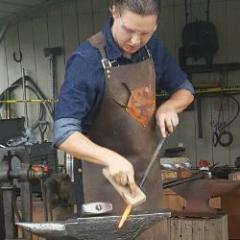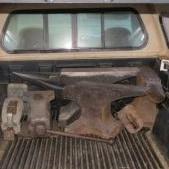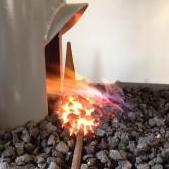
peacock
Members-
Posts
706 -
Joined
-
Last visited
Profile Information
-
Gender
Male
-
Location
Hamilton Mo.
-
Interests
power hammers , welding, mules
Converted
-
Location
hamilton mo.
Recent Profile Visitors
-
Questions about a Murray
peacock replied to TravisF's topic in Power Hammers, Treadle Hammers, Olivers
I have one and they are good hammers. Be aware that NO Little Giant parts interchange with these hammers. You can buy new springs and dies from little giant, and if you custom make a few parts you can use all the dupout linkage from a LG but you must replace both arms and the springs and pins. -
Dropped 25# little giant when moving
peacock replied to KeithSS's topic in Power Hammers, Treadle Hammers, Olivers
Take off all the old pulley center it up in a lathe turn a shoulder to bolt a 2 groove v-belt pulley. I have fixed 2 this way it's a good fix -
Treadle stop won't come close as the temp. of the stock will change as you forge so the same treadle position will yield different thickness. I saw cymbals been made once. They casted, forged, then spin. Setting up a spinning lathe is not much trouble.
-
Belts slipping on 50 lbs LG
peacock replied to 78sharpshooter's topic in Power Hammers, Treadle Hammers, Olivers
Are you sure you are running the belts the right direction? Link belts have arrows on the back to show which way to run them. They don't grip well the wrong way. -
50 lb Little Giant brake pad?
peacock replied to SoCal Dave's topic in Power Hammers, Treadle Hammers, Olivers
It will be fine if the metal band fits good. -
25 lb lg foundation question
peacock replied to alex b.'s topic in Power Hammers, Treadle Hammers, Olivers
I poured my 40x42 ft. shop floor a full 6 inches thick with full length #6 rebar every 9 inches both ways 7 bag mix. That was 13 years ago. I have had several hammers set on 1/2 inch conveyor belt bolted down with epoxy anchors. No cracks at all. 125# Bradley , 55kg air hammer, 50# LG all in a 12 foot square area. The clay dirt under the slab was compacted to the point a 10,000 lb. sheep's foot made less than an inch. impression. This all may sound like over kill but I was pouring bridge decks at the time and had the equipment and crew. Sure is nice when I change hammers not to have to think about where is the base. -
Say Mak SM 50 Base Hole Location
peacock replied to bbehnke's topic in Power Hammers, Treadle Hammers, Olivers
Plumb your exhaust onto a 30 gal. drum with some lathe turning in it . put the pipe in the bottom the turnings on top of the end of pipe make a loose fitting cover. will be better if it is out side the shop. may have to clean it a time or two a year. -
Say Mak SM 50 Base Hole Location
peacock replied to bbehnke's topic in Power Hammers, Treadle Hammers, Olivers
that is all correct. -
Say Mak SM 50 Base Hole Location
peacock replied to bbehnke's topic in Power Hammers, Treadle Hammers, Olivers
That is the very short version. In real time this all played out over 6 or 7 years and several dozen hammers with 2 or 3 trips per year by Tom to Turkey. -
Say Mak SM 50 Base Hole Location
peacock replied to bbehnke's topic in Power Hammers, Treadle Hammers, Olivers
You will need to measure the hammer you are going to use. I know Tom had some trouble with the factory not getting the pattern the same on some of the early hammers. -
A point that I thought everyone knew but found out they did not. When you are trying to warm a hammer with external heat (heat lamp/blanket etc) only the ram cylinder needs heat any heat applied to the pump cylinder does very little good unless your motor is having trouble starting up. An electric blanket like you put on a bed draped over the ram does a pretty good job. A halogen shop light close to the ram is my latest favorite.
-
Is it worth a try?
peacock replied to CleetisMorgan's topic in Power Hammers, Treadle Hammers, Olivers
That is a book binding stapler don't destroy it by trying to make something out of it that will break it. Get it working and sell it to make or buy what you want. Any thing it will forge you can do easier and faster with a hand hammer

.thumb.jpg.04efa31b17e0217d84870be46a7a0461.jpg)


